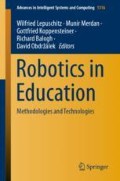Abstract
Development of automation and robotics causes a need for implementing an innovative approach towards teaching. It is especially important for vocational education, as for this an expensive equipment is needed to train within real-life setups. Thus, AR and VR technologies give an opportunity to decrease costs, while keeping a high level of course-taught skills and knowledge. The paper consists of an overview of possible applications of virtual and mixed realities for education purposes and a presentation of MILAN project. This involves a description of key ideas for skill-transfer based on e-learning platform using various ICT solutions; VR and AR among others. Also, already implemented VR methods in two robotics-training cases are presented.
Access this chapter
Tax calculation will be finalised at checkout
Purchases are for personal use only
References
Akçayır, M., Akçayır, G.: Advantages and challenges associated with augmented reality for education: a systematic review of the literature. Educ. Res. Rev. 20, 1–11 (2017)
Dalle, M.M., Dini, G., Failli, F.: An integrated environment based on augmented reality and sensing device for manual assembly workstations. Procedia CIRP 41, 340–345 (2016)
Dunleavy, M., Dede, C., Mitchell, R.: Affordances and limitations of immersive participatory augmented reality simulations for teaching and learning. J. Sci. Educ. Technol. 18(1), 7–22 (2009)
Fehling, C.D., Müller, A., Aehnelt, M.: Enhancing vocational training with augmented reality. In: Proceedings of the 16th International Conference on Knowledge Technologies and Data-driven Business, October 2016
Henrysson, A., Ollila, M., Billinghurst, M.: Mobile phone based augmented reality. In: Emerging Technologies of Augmented Reality: Interfaces and Design, pp. 90–109. IGI Global (2007)
Kamarainen, A.M., Metcalf, S., Grotzer, T., Browne, A., Mazzuca, D., Tutwiler, M.S., Dede, C.: EcoMOBILE: integrating augmented reality and probeware with environmental education field trips. Comput. Educ. 68, 545–556 (2013)
Kustandi, C., Fadhillah, D.N., Situmorang, R., Prawiladilaga, D.S., Hartati, S.: VR use in online learning for higher education in indonesia. Int. J. Interact. Mobile Technol. (iJIM) 14(01), 31–47 (2020)
Martín-Gutiérrez, J., Mora, C.E., Añorbe-Díaz, B., González-Marrero, A.: Virtual technologies trends in education. EURASIA J. Math. Sci. Technol. Educ. 13(2), 469–486 (2017)
Michalos, G., Karagiannis, P., Makris, S., Tokçalar, Ö., Chryssolouris, G.: Augmented reality (AR) applications for supporting human-robot interactive cooperation. Procedia CIRP 41, 370–375 (2016)
Pilat, Z., Goszczyński, T., Klimasara, W., Słowikowski, M., Zieliński, J.: Use of the ICT in vocational training in the area of industrial robotics and automation. In: 7th International Conference Mechatronic Systems and Materials (MSM 2011), pp. 7–9 (2011)
Porcelli, I., Rapaccini, M., Espíndola, D.B., Pereira, C.E.: Technical and organizational issues about the introduction of augmented reality in maintenance and technical assistance services. IFAC Proc. Vol. 46(7), 257–262 (2013)
Yilmaz, R.M.: Augmented reality trends in education between 2016 and 2017 years. In: State of the Art Virtual Reality and Augmented Reality Knowhow, vol. 81, p. 97 (2018)
MILAN project. http://milan-project.eu/. Accessed 21 Jan 2020
Centre for Research and Development of Modern Technologies CBiRNT, Wrzesnia, Poland. http://cbirnt.wrzesnia.powiat.pl/
Acknowledgements
The paper presents results of researches supported by EU within the project MILAN “Multifunctional Innovative Learning Assisting Network for VET in Advanced Manufacturing”, 2018-1-PL01-KA202-050812, under the ERASMUS+ Programme. This publication represents only author´s opinion and neither the European Commission nor the National Agency is not responsible for any of the information contained in it.
Author information
Authors and Affiliations
Corresponding author
Editor information
Editors and Affiliations
Rights and permissions
Copyright information
© 2021 The Author(s), under exclusive license to Springer Nature Switzerland AG
About this paper
Cite this paper
Falkowski, P. et al. (2021). The Concept of Using AR and VR Technologies in the Vocational Training System in Robotics and Automation. In: Lepuschitz, W., Merdan, M., Koppensteiner, G., Balogh, R., Obdržálek, D. (eds) Robotics in Education. RiE 2020. Advances in Intelligent Systems and Computing, vol 1316. Springer, Cham. https://doi.org/10.1007/978-3-030-67411-3_29
Download citation
DOI: https://doi.org/10.1007/978-3-030-67411-3_29
Published:
Publisher Name: Springer, Cham
Print ISBN: 978-3-030-67410-6
Online ISBN: 978-3-030-67411-3
eBook Packages: Intelligent Technologies and RoboticsIntelligent Technologies and Robotics (R0)

